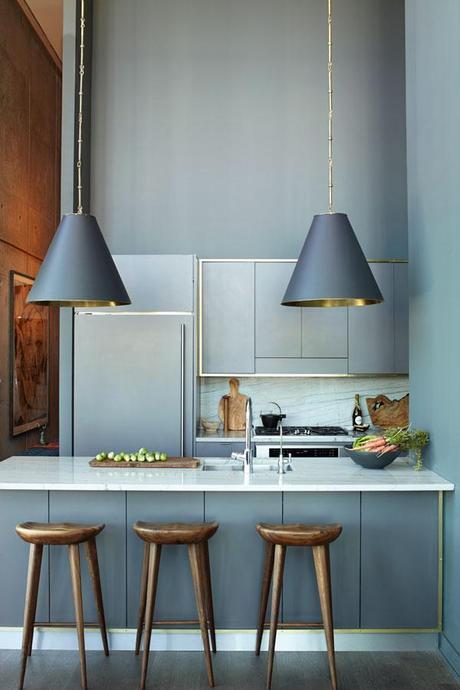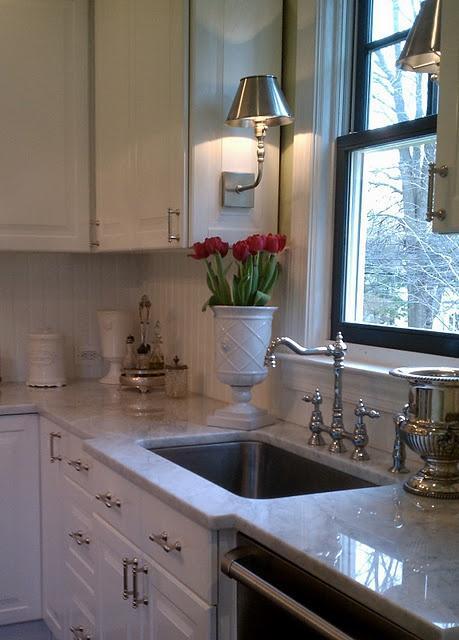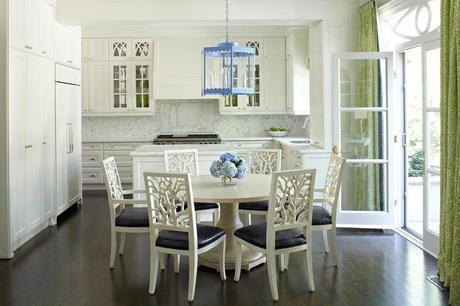 via The Decorista
via The Decorista
Lately I’ve been spending a lot of time researching and sourcing light fixtures. I’m a believer that lighting can make a tremendous impact in any space, and the kitchen and bath are no exceptions. Often times people fail to see how both the proper amount and type of lighting are necessary components when creating a functional, beautiful space. More importantly, lighting is often overlooked since people don’t realize that it is a decorating opportunity that’s well worth the time it takes to select just the right fixtures.
 via Houzz
via Houzz
When designing a lighting plan for a kitchen (or most rooms, for that matter) I want the lighting to be flexible. For example, there are times when I’m cooking that I want my kitchen to light up like Yankee Stadium. When entertaining, I want to create a mood that can only be achieved when certain lights are on. And at the end of the night when the dishes are done and the kitchen is clean, I might only flip on one or two accent lights so no one is fumbling in the dark to grab a late-night snack. When you’re designing your kitchen, consider a variety of light sources. A combination of recessed lighting, island pendants, sconces and a fixture over the table all will provide both the appropriate amount of light for each designated area and the variety you need to keep it interesting.

Consider the following guidelines when installing your light fixtures:
- When installing a fixture over a dining table, begin by holding the light 30″ above the table surface for a room with an 8′ ceiling. Add 3″ for every foot that you add to the ceiling height (for a 9′ ceiling try 33″).
- When hanging pendant fixtures over an island, consider that the bottom of your light fixture should be roughly 28-34″ above the countertop. Once again, if your ceiling is higher than 8′ you might consider hanging pendants a little bit higher. Some situations do call for as much as 40″ over the island, so bear in mind that every space is different.
- When installing sconces in a bathroom, for example, a general guideline for where to begin is 64″ from the floor. Oftentimes, homeowners and electricians have a natural inclination to install these fixtures much higher than they need to be. But who wants to stand at the sink and look straight into the bulb? The purpose of a bathroom sconce is not only to shed light so that you can see what you’re doing, but it’s also to act as a decorative element in the room, no??
How you choose to install your light fixtures is ultimately up to you. Customers and friends always ask if there’s a rule to follow when making these decisions. Unfortunately, the answer is no — it’s simply not that easy. There are guidelines, to be sure, but in the end, it’s your decision. For me, I often err on the side of having a light fixture hang a little bit lower as opposed to a little bit higher since I believe that lighting on the lower side creates a sense of coziness and adds a bit of ambiance — but that’s just my opinion. What I do tell customers is that determining the correct height to hang any fixture is best done with two people. One person should hold the fixture in place while the other person observes the fixture from multiple vantage points. First, sit at the island or table — can you see the person across from you or is the light fixture in the way? Enter the room from each doorway and look towards the island and/or the table — do you like what you see? Is the light fixture too high or too low? Does it block the view beyond the fixture? Remember: lighting serves a dual purpose. It’s meant to illuminate the space and to be beautiful at the same time. Lighting is an investment, so I suggest you treat it as such and take the time to make sure that the fixtures you choose hang at the height that is the most pleasing to you!

